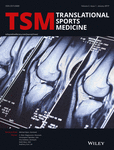Badminton preferentially decreases explosive over maximal voluntary torque in both the plantar flexors and extensors
Funding information
Funding received from Badminton World Federation (BWF).
Abstract
We assessed changes in maximal and explosive plantar flexion (PF) and dorsi flexion (DF) torque, and thus the maximal and explosive DF/PF ratio, in response to successive badminton matches (2 × 35, 15 minutes of rest) in 16 juniors (10 males, 6 females) International-level badminton players before (Pre), immediately after the first (Post-1) and second (Post-2) match as well as after resting for 12 hours. For both PF and DF, maximal voluntary torque decreased from Pre to Post-2 (~7%-9%; P < 0.05). Compared with Pre, PF explosive voluntary torque decreased by ~4%-13% at Post-1 (P < 0.05), with further reductions ranging from −15% to −25% within the 0-100 ms epoch after contraction (P < 0.001) at Post-2. Decrements of similar magnitude in DF explosive voluntary torque occurred at Post-1 (ranging −7% to −27%) and Post-2 (ranging −3% to −28%) relative to Pre (P < 0.05). All neuromuscular parameters were fully recovered after 12 hours of rest. Explosive DF/PF ratios during the very initial phase of contraction (up to 50 ms from onset) were lower compared with the maximal DF/PF ratio, with no effect of time (all P < 0.05). In badminton, explosive torque indices should be included to more accurately reflect acute fatigue induced by successive badminton matches.
CONFLICT OF INTEREST
The authors have no conflict of interest to disclose.




